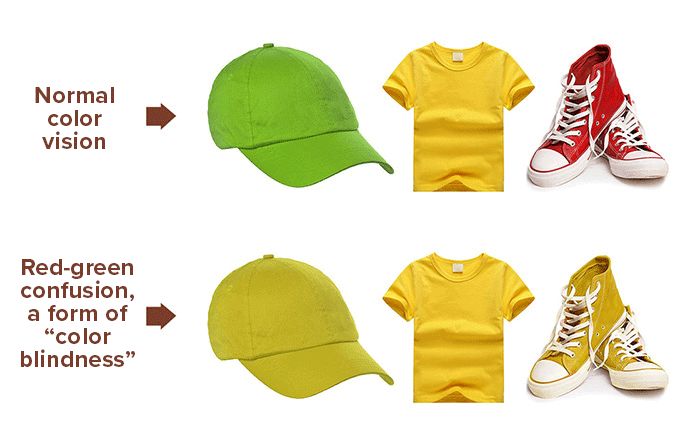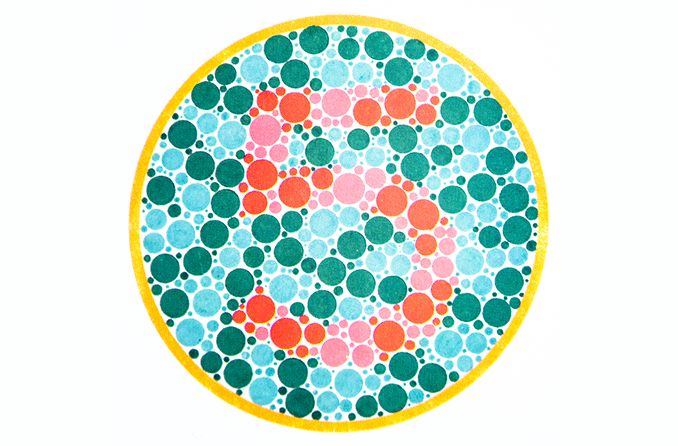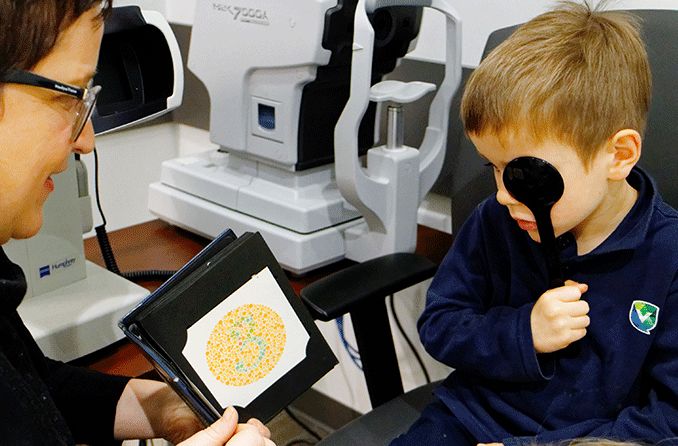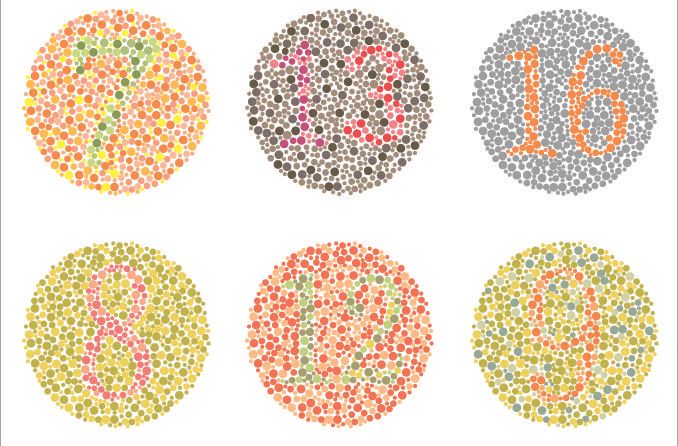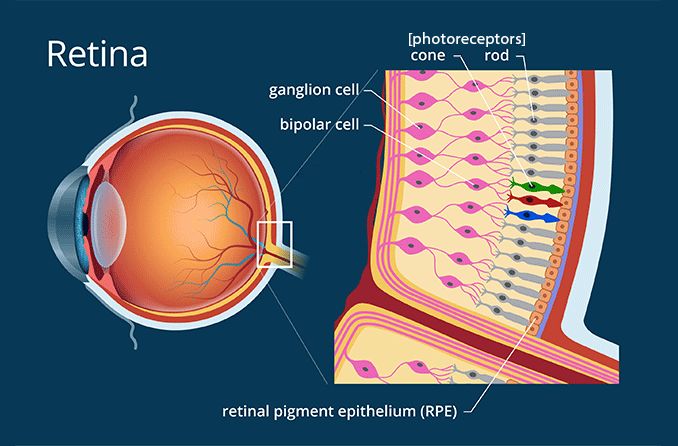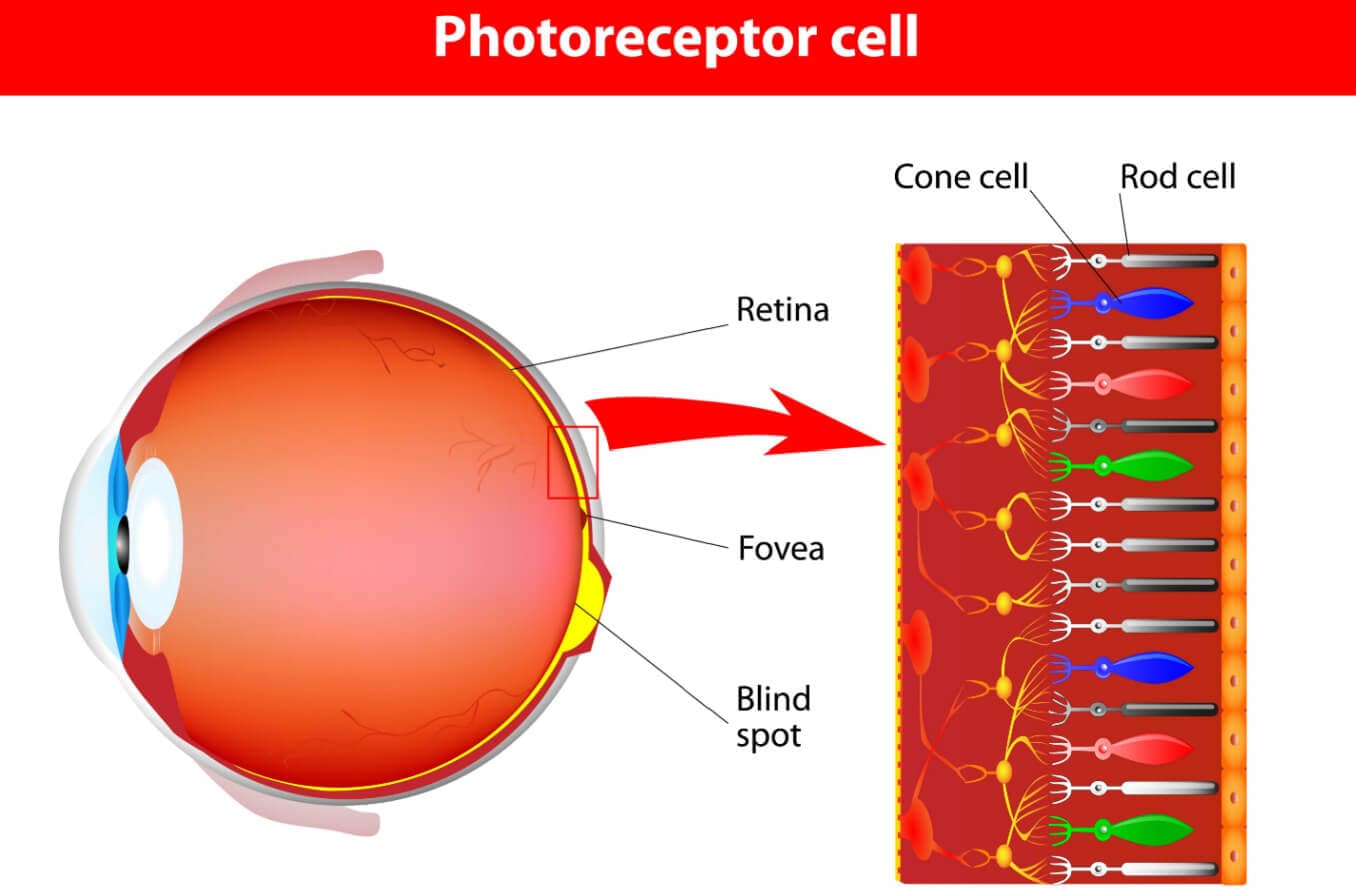What is color blindness?
Color blindness is not a form of blindness at all, but a deficiency in the way you see color. If you’re colorblind, you have difficulty distinguishing certain colors, such as red and green or blue and yellow.
Color blindness (or, more accurately, color vision deficiency) is often an inherited condition that affects males more frequently than females. According to Prevent Blindness, an estimated 8% of males and less than 1% of females have color vision problems.
Red-green color deficiency is the most common form of color blindness.
Much more rarely, a person may inherit a trait that reduces their ability to see blue and yellow hues. This blue-yellow color deficiency usually affects men and women equally.
Color blindness occurs when light-sensitive cells in the retina fail to respond properly to variations in wavelengths of light that enable people to see an array of colors.
Photoreceptors in the retina are called rods and cones. Rods are more plentiful (there are approximately 120 million rods in the human retina). While they’re more sensitive to light, rods are incapable of perceiving color.
The 6 million to 7 million cones in the human retina are responsible for color vision. These photoreceptors are concentrated in the central zone of the retina called the macula. Cones are categorized based on the color of light waves they sense:
- Red-sensing cones
- Blue-sensing cones
- Green-sensing cones
The center of the macula is called the fovea. This tiny (0.3 mm diameter) area contains the highest concentration of cones in the retina and provides your most acute color vision.
Color vision deficiency vs. true color blindness
While most people call the inability to accurately distinguish colors "color blindness," color vision deficiency is the preferred term. It refers to having a limited ability to distinguish between certain colors. People with the condition still see colors, but their perception of them is affected in some way.
True color blindness, known as achromatopsia, is a rare condition in which a person doesn’t see any colors at all.
What are the signs and symptoms of color blindness?
Do you have difficulty telling if colors are blue vs. yellow or red vs. green? Do other people sometimes inform you that the color you think you’re seeing is wrong? If so, these are primary signs that you have a color vision deficiency.
Most people who are considered "color blind" can see colors. But certain colors may appear washed out or may be confused with other colors, depending on the type of color vision deficiency they have.
If you develop color vision problems after you were previously able to see a full range of color, visit your doctor. A sudden or gradual loss of color vision could indicate an underlying health problem that may be affecting your vision.
Types of color blindness
There are different types of color vision deficiencies, each classified according to the cone types that are affected. The main categories include:
Red-green color deficiency
This is the most common type and results in difficulty distinguishing between shades of red and green. This impacts real-life tasks like reading traffic lights, interpreting color-coded information and cooking. It can make it hard to judge the ripeness of some foods, tell the difference between red and green LED lights, and match outfits. Red-green color deficiency is further grouped into the following forms:
- Protanomaly – Red-sensing cones do not function properly. This is also a mild form of the condition.
- Deuteranomaly – Green-sensing cones do not function properly. This is a mild form and the most common variation of red-green color deficiency.
- Protanopia – Red-sensing cones are absent, meaning a person is unable to distinguish red from other colors.
- Deuteranopia – Green-sensing cones are absent, meaning a person is unable to distinguish green from other colors.
Blue-yellow color deficiency
People with this type of color blindness have missing or malfunctioning blue cones. Blue-yellow color blindness includes two variations:
- Tritanomaly – Blue cones are present, but they don’t function properly. This type may also affect the ability to see yellow.
- Tritanopia – Blue cones are absent, meaning a person is unable to distinguish blue from other colors.
Blue cone monochromacy
This form of color blindness occurs when blue cones function properly, but red and green cones do not.
Rod monochromacy (achromatopsia)
Rod monochromacy is the absence of all cone types, or the cones are completely nonfunctional. This type of color blindness is rare.
What causes color blindness?
Genetic factors are the most common cause of color blindness. Inherited forms are often related to deficiencies in certain types of cones or the absence of those cones. Men are at a higher risk than women of being born with color vision problems.
Besides differences in genetic makeup, other factors can increase the risk of color vision defects or loss, including:
- Neurological diseases – Conditions such as Parkinson’s disease and Alzheimer’s disease can affect the visual system and lead to color vision issues. Neurological diseases that affect the optic nerve, such as multiple sclerosis (MS), can cause a "red desaturation" where red colors appear faded out.
- Cataracts – Clouding of the eye's natural lens that occurs with cataracts can cause a loss of blue light perception. This can make everything look dull and more yellowish to brown. Cataract surgery can improve color vision by replacing the cloudy lens with an artificial intraocular lens (IOL).
- Diabetes – The main reason diabetes can affect color vision is because of diabetic macular edema. This is the most common cause of vision loss in diabetic patients. Since the color receptors are in the macula, fluid buildup can damage color vision and make things appear faded out.
- Glaucoma – This is a group of conditions that damage the optic nerve. Glaucoma affects blue-yellow range most. It can make it difficult to tell these colors apart, particularly if they’re similar to their background.
- Age-related macular degeneration (AMD) – This condition affects the macula, the central part of the retina. People with AMD may find that colors no longer look as bright or intense as they used to.
- Certain medications – Some medications have been linked to color vision changes in some patients, including tiagabine (an anti-seizure drug), hydroxychloroquine (prescribed for rheumatoid arthritis), digoxin (a heart medication), sildenafil (Viagra) and ethambutol (an antibiotic).
- Leber's hereditary optic neuropathy – This is an inherited type of optic neuropathy, a condition affecting the optic nerve. It can affect a person’s central and color vision.
- Kallmann syndrome – This is an inherited hormonal disorder that can sometimes lead to color vision problems.
- Injury or damage – An injury or damage to the eyes or areas of the brain where visual processing takes place can cause color vision issues.
- Aging – The aging process causes changes in eye structures, such as the eye’s natural lens and the retina. This can affect color vision.
Is red-green color blindness hereditary?
Red-green color blindness is the most common inherited form of color vision deficiency. It is caused by a fairly common X-linked recessive gene.

Mothers have an X-X pairing of chromosomes carrying genetic material. Fathers have an X-Y pairing of chromosomes. A mother and father each contribute chromosomes that determine the sex of their baby.
When an X chromosome from one parent pairs with an X chromosome from the other parent, the baby will be a girl. And when an X chromosome from the mother pairs with a Y chromosome from the father, the baby will be a boy.
If you have red-green color blindness caused by an X-linked recessive gene, your mother will be a carrier of the gene or be color-deficient herself.
Fathers with this inherited form of red-green color blindness pass the X-linked gene to their daughters but not to their sons. Because a son receives the Y chromosome from his father, he cannot receive the X-linked genetic material from his father.
A daughter who inherits the color-deficient gene from her father will be a carrier of the gene. But she will not be color blind unless her mother carries the gene and also passes the X chromosome with the color-deficient gene to her daughter.
When a mother passes along this X-linked trait to her son, he will inherit the color vision deficiency. He will likely have trouble distinguishing reds and greens.
Again, a daughter can be a carrier but will have this form of color blindness herself only when both her father and mother pass along the X-linked gene. This is why more men than women are color blind.
SEE RELATED: Tetrachromacy
How is color blindness diagnosed?
Doctors typically diagnose color blindness through a series of tests. Some of the more common color blind tests include:
Color plate tests
These tests, such as the Ishihara test, involve viewing plates or charts. They feature patterns of colored dots arranged to form symbols or numbers. People with normal color vision see specific figures. People with certain color vision deficiencies see different figures or no figures at all.
Anomaloscope test
During this test, the patient looks at two colored light fields through a special device. The patient uses knobs to adjust the brightness and intensity of one field until it matches the other.
Hue tests
These tests involve arranging a set of colored blocks, cards or other objects in order by hue. It evaluates how well a person can distinguish differences between color shades.
Early diagnosis of color vision deficiency may help address and prevent learning problems during the school years, especially since many learning materials rely heavily on color.
How do you treat color blindness?
Currently, there is no cure for inherited color blindness. However, there are strategies and tools to help people function better in a color-oriented world. Researchers are also exploring gene therapy as a potential treatment option.
Addressing underlying conditions
Treating underlying health conditions that contribute to color blindness may help improve deficient color vision.
Coping strategies
Most people are able to adapt to color vision issues without too much trouble. But some professions require differentiating between colors depend on accurate color perception. For example, properly handling various colors of electrical wiring could be difficult or impossible for someone with color vision deficiency.
You can learn ways to work around the inability to distinguish certain colors. For example, you might organize and label your clothing to avoid color clashes. (Ask friends or family members who have normal color vision to help with this project.)
You could also learn to recognize certain colored items by their order rather than their color. For example, the red light is at the top of the traffic signal and the green light is at the bottom.
Apps and technology
A variety of downloadable apps to assist with color detection have been developed for digital devices. Users can take a photo of an object, and the app identifies the colors in the image.
Support for children
If your child has a color deficiency, discuss it with their teachers. They may be able to adjust their lessons and presentations to support your child’s learning.
See an eye doctor for additional help and guidance if you suspect your child may be colorblind.
Gene therapy
While gene therapy has been used to cure red-green color blindness in monkeys, similar treatments for humans are still being studied. So far, no gene therapy has been approved to correct common forms of color blindness in humans.
Special glasses and lenses for colorblind people
Some people use special lenses to enhance color contrast and perception. These filters are available in both eyeglasses and contact lenses.
One example is color blind glasses developed by a company called EnChroma. The tinted lenses in EnChroma’s glasses include patented light-filtering technology. They’re designed to give people with common forms of color blindness the ability to see a broader spectrum of bright colors.
While colorblind lenses may help people distinguish between some colors in certain instances, they cannot correct color vision deficiencies. Additionally, experts caution that they should not be worn at night or while driving.
Your eye doctor can help you determine whether color blind glasses are a good choice for you.
READ NEXT: Contacts for color blindness

